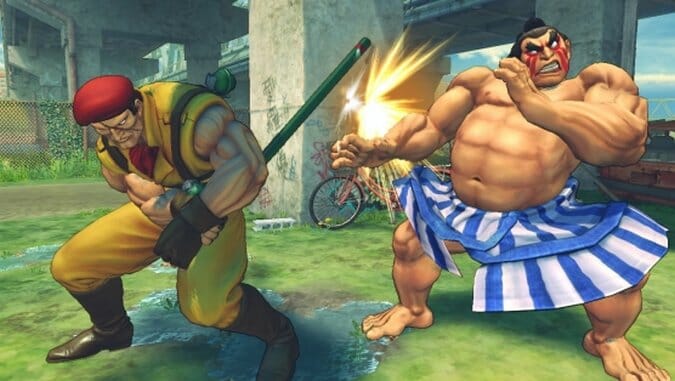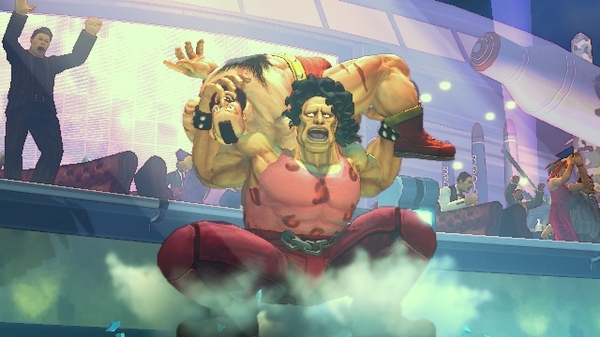
There’s no possible way to review Ultra Street Fighter IV other than saying it’s Street Fighter. Street Fighter IV has been around since 2008 and it made fighting games hugely popular again. 130,000 people were watching it at EVO last month. I was one of those people! I watched a guy with an original Playstation controller win the grand finals with the character Rose, not considered especially strong, in a room full of queer and awesome and precious people. We screamed a lot, it ruled, there was pizza, and I understand sports now!
Ultra Street Fighter IV introduces five new characters in the thriftiest way possible—one of them reuses the model from an existing character, the other five are imported from Street Fighter X Tekken (don’t worry about it)—as well as adding a few tweaks to the rules of the game and adjustments to all of the characters. The intention is to make the game more balanced, the eternal and impossible quest of making every character in the game equally fair with an equal chance of winning against everyone else. This is a noble goal and it’s very important work to make sure the game doesn’t become too absurd or frustrating. The last revision, Super Street Fighter IV: Arcade Edition, took the philosophy that two of the characters they were introduced would be just absurdly good, a nostalgic throwback to the days of Street Fighter III where a tiny handful of characters dominated the scene. The community begged for mercy quite instantly and a 2012 update was released a year later, which kind of has me wondering if maybe the original intention wasn’t to capitalize on nostalgia for Street Fighter III but to snap the rose colored glasses of the community. Sorry, Capcom tends to encourage that sort of conspiracy theory when it’s probably just that there’s less than a dozen people still working on the game full time (if that.)
There are other reasons to make changes than the sense of balance, one of which is to keep the game interesting. Videogames require a certain degree of physical skill, but they also have very strict rules that players are always trying to understand better in order to exploit them. Street Fighter IV is like a puzzle box that millions of people share, and with enough people working on it for a long enough time, some of those puzzles will eventually get solved. There’s no competitive game more iconic than chess, but chess is getting dangerously close to being solved: It’s been played for so long and information about it can be shared so easily that games start to look exactly like each other as both players chose optimal predetermined strategies. So Ultra Street Fighter IV adds a few little things—a “red focus” attack that has an extremely specific use and the ability to delay standing on the ground, both of which won’t be very interesting or relevant to new players but are a new toy for the highest level players to play with and create new and interesting strategies. Balancing is a…balance. If changes are made too quickly, players don’t have time to understand the system or grow community understanding of it. Sometimes the community is able to solve even character balance problems itself, just by learning new ways to learn characters that were once considered too weak. If a game is left for too long, though, it’s solved to the point where it isn’t interesting anymore.
This is all quite theoretical because the impact of the changes is still being assessed, even with EVO played in Ultra Street Fighter IV. The four characters from Street Fighter X Tekken—Poison, a well-rounded character with a few interesting quirks but no outstanding features; Hugo, an obvious nod to Andre The Giant with a very interesting set of grabs but a distinct weakness in his size; Elena, who only attacks with kicks and has an aggressive reach; and Rolento, who can hop around on his staff and quickly roll under attacks—range from easy to use to really quite unique, and Decapre, though she uses Cammy’s old model, is one of the weirdest and most technical characters in the game. The consensus on these characters is that they are mediocre at best in overall power, yet all but Hugo were played by people in EVO’s top 48. The relative strength of the rest of the cast has been rebalanced as well—Juri, Evil Ryu and Rose have leapt near the top, though they were all good before, while Gen, Sakura and Sagat have plummeted from being close to the top to merely pretty decent. But much has also stayed the same. Fei Long, Akuma and Cammy remain incredibly strong, while perennial losers Hakan, Dee Jay and Dan remain safely at the bottom. Ultra is still young, however, and whether that means no one has figured out how to use them best yet or that they’re interesting more in theory than practice remains to be seen. What works in theory does not always work in practice, and what works in practice is sometimes surprising: The top 16 at EVO never looks like a screenshot of a tier list.
From reports I have heard in the fighting game community, it seems that Ultra is prone to some weird bugs, including an unintended rebalancing of several new characters which is starting to show that Capcom is withdrawing even more of their investment in Street Fighter IV and the ensuing quality assurance. Ultra Street Fighter IV is a game that is still alive, but it’s also a miracle that the same game has held on in one form for an entire hardware generation. But Ultra Street Fighter IV is continuing something that might already be kind of finished, whatever that means for a game. It has a massive cast, a very refined series of system mechanics that are original and faithful to the game’s roots, and while Ultra certainly doesn’t bring the game down or anything (though the PC version is experiencing some embarrassing bugs) this revision is more of a finishing touch compared to the substantial revisions of the past, which deeply fleshed out and expanded the cast and shaped the system’s most celebrated features. There’s even a “version select” that lets you pick previous iterations of the whole cast, so you can relive the dominance of Sagat in the original Street Fighter IV all over again…but, please don’t.
Fighting games essentially are Street Fighter, and here’s an edition that again scoops up all the other editions and makes it fairly clear what you are actually buying. If you want to understand fighting games and think that EVO is cool, or if you think that EVO is cool by association because you watched it in a pile of lesbians in a hotel in San Francisco, you can actually buy it and have fun losing a lot at it like I am right now. Street Fighter is Street Fighter! Ultra Street Fighter IV is not here to shake anything up. It is here to be a reason to keep playing Street Fighter, an excuse to pick up Street Fighter again, a chance to finally learn how to play Street Fighter. And Street Fighter is its own reward.
Ultra Street Fighter IV was developed and published
by Capcom. It is available for the Xbox 360, Playstation 3 and PC.
Aevee Bee is freelance writer who maintains a surreal videogame terror blog at mammonmachine.com and a twitter account, @mammonmachine, which is both a popular resource for anime puns and flirtation advice.
